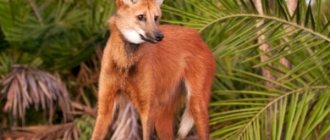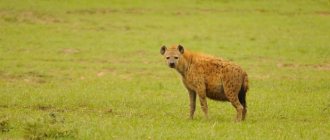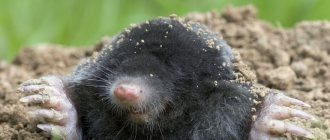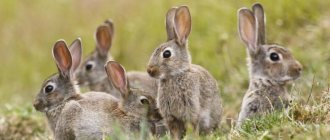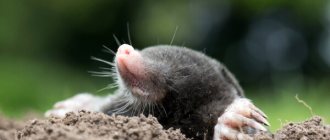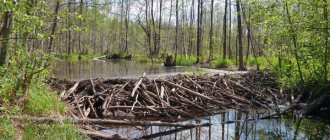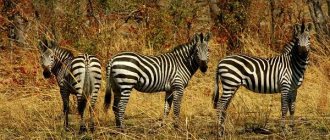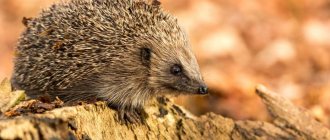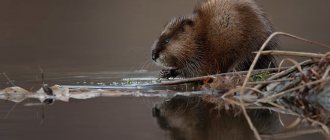- Reports
- Animals
- Beavers
Beavers are mammals that are among the largest rodents on Earth. Scientists suggest that the ancestors of these animals originally lived in Asia. They were huge. Their body length exceeded 2.5 meters, and their weight reached 350 kilograms.
Modern beavers, living in freshwater bodies of water with rich coastal vegetation, are significantly smaller than their extinct predecessors. Adult individuals weigh 30-45 kilograms and are about 1.3 meters long. Females are slightly larger than males.
These animals have a large head, a narrow muzzle, small eyes, wide short ears, a squat body, a rather long tail similar in shape to an oar, short five-fingered limbs with strong claws. Since beavers lead a semi-aquatic lifestyle, they have swimming membranes on all limbs (and they are better developed on the hind limbs than on the front ones).
Beavers have very beautiful fur. It is usually brown, but can also be dark red, chestnut, or black. It consists of several layers and gets wet slightly in water, so it protects well from the cold. Animals regularly groom it by combing it with the forked claw of the second toe of the hind limbs.
On land, beavers move clumsily, but when they get into the aquatic environment, they become agile and fast. They dive great. They can stay underwater for up to 15 minutes, swimming approximately 700-750 meters during this time period.
In summer they are active at dusk and at night, but in winter they work even when it is light. When the temperature is too low, they prefer not to stick their heads out of their homes.
Beavers' homes are burrows or huts, the entrances to which are always made under water to ensure safety. The beaver digs a hole resembling a labyrinth where the bank is steep and steep. If the banks of the reservoir are flat and low, then he makes a cone-shaped hut from brushwood, using silt and earth to hold it together.
To maintain the required water level, these tireless workers build dams. They eat only plant foods: bark, tree shoots, grass. They love acorns.
Beavers are distinguished by their loyalty to their partner. They can reproduce after reaching two years of age.
Appearance
The beaver is well adapted to life on land and in water. The body height of an adult reaches 35 cm, length - 1 m, and weight reaches 30 kg. The animal bends down to the ground, it has short legs with five fingers, between which membranes grow. Thanks to them, the mammal can swim.
It is difficult to distinguish a female from a male, although the former may be larger. The beaver's flat tail is like an oar. Its length reaches 30 cm, and it is not covered with hair. And on top of it there is a horny growth that looks like a keel.
Short and wide ears are hidden under the fur. And when diving, small eyes are covered with nictitating membranes. Beavers' teeth grow without roots, and the incisors are covered with labial outgrowths. Thanks to this, the animal actively uses them even under water.
Beaver fur can be of different colors - from light chestnut to black. It consists of hard bristles with a silky down. Molting occurs at the end of spring and lasts until the first frost.
The mammal releases a beaver stream from paired glands located near the anus. A special secret that is included in it allows animals to mark territory and recognize each other at a great distance.
Where do beavers live?
Beavers live in Europe (Scandinavian countries), France (lower Rhone River), Germany (Elbe River basin) and Poland (Vistula River basin). Beavers are also found in forest and forest-steppe zones of the European part of Russia, Belarus, and Ukraine.
In Russia, the beaver lives in the Northern Trans-Urals. Beavers live scatteredly in the upper reaches of the Yenisei River, in the Kuzbass (Kemerovo region), in the Baikal region, in the Khabarovsk Territory, in Kamchatka, in the Tomsk region. In addition, beavers are found in Mongolia and Northwestern China.
Beavers live with full equipment to lead a semi-aquatic lifestyle. Their ear openings and nostrils close underwater. And special nictitating membranes cover their eyes, which allows them to see well in the water. The oral cavity is designed so that water does not enter it while the animal is working under water. The function of a rudder in the water is performed by the beaver's tail.
Beavers live, preferring to inhabit the banks of calm rivers and lakes, ponds and reservoirs. They avoid fast and wide rivers, as well as reservoirs that freeze to the bottom in winter. For these rodents, the presence of soft deciduous trees and the presence of aquatic, herbaceous and shrub vegetation in coastal zones and along the banks of a reservoir are important.
Beavers dive and swim well. Thanks to their large lungs, they can stay underwater for up to 15 minutes and swim up to 750 meters during this time. Therefore, beavers feel more confident in water than on land.
Lifestyle
For permanent residence, beavers choose areas near slow-flowing rivers. Lakes, ponds, and reservoirs are also suitable. Large bodies of water with raging streams are dangerous for them.
For normal life, it is important that there are deciduous trees and shrubs nearby, and that the banks are covered with grass. Animals can eat it. Mammals feel even better in water than on land. They swim well, dive to depths, and are able to hold their breath for a long time due to the large volume of their lungs and liver.
If a beaver senses danger, it hits the water with its tail to warn its fellows. River animals can live alone, but more often they form groups of up to eight individuals. If their way of life is not disrupted, then mammals will remain in one place for decades.
Activity occurs at night. Then the beavers can move 150-200 meters away from their pond, marking mud mounds along the way. In summer and autumn, animals work on building a home, and in winter they rest in it. The lifespan of beavers is 15 years, but in captivity it increases by another 10.
Lifespan
In the natural world, the life expectancy of a beaver is 10-20 years, but in modern times this value is much higher and amounts to 35 years.
The beaver is a valuable species and has a high commercial value. Its fur is widely used. Also, in addition to the skin, beaver meat is used, which has healing properties. Quite widely in folk medicine, its glands are used, so-called in common people (beaver stream).
Habitats
The animal's home is called a hut. This structure has several passages that are located under water. The beaver coats the corridors with clay from the inside, and the structure itself is built in the shape of a cone.
And on rivers, mammals build dams from logs or trees that have fallen into the water. The dimensions of such a structure are significant:
- height - 5 m;
- width - 6 m;
- length - 30 m.
Beavers use trees not only as building material. They feed on branches and sharpen their teeth on trunks. Animals take uneaten shoots to dams or dwellings, trampling paths. In the fall they are flooded with rain, which is why they are called beaver canals.
Beavers are found in many countries:
- Russia;
- China;
- Mongolia;
- Ukraine;
- Belarus.
They are also found in other European countries, and the Canadian species lives in North America. In the chosen area they create a special landscape.
The character and lifestyle of the beaver
Beavers are semi-aquatic animals that feel more confident in water, swim and dive well, and on land the beaver has the appearance of a clumsy animal . Animal activity increases towards dusk and with the onset of night. In the summer they can work 12 hours. Only in winter, in severe frosts, do they not leave their secluded dwellings. Burrows or so-called huts are places where beaver families live.
The entrances to the burrows are hidden by water and lead through complex labyrinths of coastal areas. Emergency exits ensure the safety of animals. The living chamber is more than a meter in size and approximately 50 cm high, and is always located above the water level.
A beaver can build dams that can easily support a person's weight.
A special canopy protects the place on the river where the hole is located from winter freezing. The foresight of beavers is akin to the professionalism of designers. The construction of huts is carried out on flat areas or low banks. These are cone-shaped structures up to 3 m high made of brushwood, silt and clay.
The inside is spacious, up to 12 m in diameter. At the top there is a hole for air, and at the bottom there are holes for immersion in water. In winter, it stays warm inside, there is no ice, and beavers can dive into the pond. Steam above the hut on a frosty day is a sign of habitation.
To maintain the required water level and preserve their lodges and burrows, beavers build well-known dams, or dams made of tree trunks, brushwood and silt. Even heavy stones up to 18 kg are found to strengthen the building.
The frame of the dam, as a rule, is a fallen tree, which is overgrown with building materials up to 30 m in length, up to 2 m in height, and up to 6 m in width. The structure can easily support the weight of any person.
The photo shows a beaver hole
Construction time takes approximately 2-3 weeks. Then the beavers carefully monitor the safety of the constructed object and carry out “repairs” as necessary. They work in families, distributing responsibilities as if as a result of precise and error-free planning.
Rodents can easily cope with trees up to 7-8 cm in diameter in 5 minutes, gnawing the trunks at the base. It copes with larger trees, up to 40 cm in diameter, overnight. Cutting into pieces and towing to a dwelling or dam are carried out in an organized and uninterrupted manner.
What kind of animals beavers have on their farm can be seen by their habitat area. Not only the dwellings, but also the channels through which building materials and feed are rafted do not contain excrement or food debris.
Paths, houses, areas for construction - everything is interconnected and tidied up. A special landscape is created, which is called beaver. Animals communicate using special scent marks, sounds similar to whistling, and tail strikes.
A tap on the water is an alarm signal and a command to hide under water. The main enemies in nature are wolves, foxes, and brown bears. But humans have caused enormous damage to the beaver population. The beaver is a hard worker and connoisseur of a quiet family life. In their free time, they take care of their fur coat, lubricating it with secretions from the sebaceous glands, protecting it from getting wet.
Animal nutrition
In a short message about beavers for grade 4, you can briefly talk about their nutrition. These animals prefer plant foods, choosing the bark and branches of some trees:
- birch;
- and you;
- poplars;
- aspen.
They also like herbaceous plants - water lilies, reeds, irises. Because of this diet, beavers have to settle in areas where they can easily find food. Sometimes they feed on hazel, bird cherry and elm. But oak and alder are used only as building materials.
Every day a mammal requires food weighing about 20% of its own weight. The special microflora of the stomach easily copes with large amounts of cellulose, and sharp teeth turn tree trunks and branches into dust.
But beavers prefer to eat only one type of wood in order to accustom their bodies to it. Although in spring and summer they feed on green plants - grass, flowers, foliage. In autumn, animals begin to stockpile supplies. One family requires at least 50 cubic meters of food for the winter.
The meaning of beaver in nature
Rodents are among the few species that change the natural landscape. For a long time, the animals were classified as pests for their ability to fell trees, but research conducted by the Wildlife Conservation Society (WCS) has proven the importance of these rodents for ecosystems.
Beaver dams retain silt and help clean the reservoir. Dams built by beavers provide a stable water level, which has a beneficial effect on coastal vegetation. Waterfowl settle in such places and often carry fish eggs on their feet. If beavers do not have time to process a fallen tree overnight, they abandon it, providing food for animals that feed on branches and bark. The sap flowing from the places where beavers undermine the trunks serves as food for insects.
The area transformed as a result of activity is called a beaver landscape.
MOLE
Offspring and reproduction
Children begin to carefully study the world around them in 4th grade. The message about beavers will be useful for those interested in the lifestyle of rodents. A child can prepare reports and abstracts about mammals independently or with the help of adults. Special attention in the text should be paid to the reproduction of beavers.
By the third year of life, river animals are already ready to create offspring. Mating begins in February and continues until the end of March. Males and females leave their homes and mark the nearest territory.
Pairs find each other using marks and mate underwater. After 3.5 months, 4-5 cubs are born. Their number directly depends on the age of the female: the older she is, the larger the offspring will be.
Mothers feed their babies milk for up to three weeks. And then they begin to feed on grass and coarser plants. But mother's milk remains in their diet for up to two months. Next, the cubs grow incisors, which allow them to cope with soft tree bark.
After two years, beavers leave their parental home. They look for their own pond and build their own huts. New families are appearing. They consist of two adults - a mother and a father, as well as their cubs, which have not yet reached the age of two.
Dam construction
An interesting message about beavers must include a description of the dams that animals build. This animal is considered the second mammal after humans, capable of adjusting the world around it to its needs.
Natural architects can use large stones and traps placed by hunters to create dams and dams. First, mammals choose a suitable place. And neither weather conditions nor human activity can drive them away from it. The beavers then change the flow of the reservoir, reducing its pressure.
The finished dam has equalization channels that optimize water pressure at different levels. The animals tilt the top of the structure in the direction opposite to the flow. Sometimes they complete the lower and upper structures so that the pressure on the main one is not strong. And mammals do all this without preliminary designs with drawings that take up several pages.
Only after the dam is installed does the construction of housing begin. Half of the hut is located above the water, and the entrances are at depth. The house is designed for a large family: the first floor serves as a dining room and living room, the second floor has sawdust-covered bedrooms.
The construction of dams is beneficial not only for the animals themselves, but also for nature. During rainy periods, deep rivers overflow their banks, flooding vegetation and animal habitats. Beavers direct the flow so that the water helps all living things develop, rather than destroying them.
Species status
A short story about beavers should contain information about the natural enemies and economic purposes of these animals. The mammal has many natural enemies. They attack young individuals, killing and eating them. Main opponents:
- wolverines;
- wolves;
- foxes;
- the Bears;
- eagle owls;
- large pikes.
But the beaver's main enemy is man. It destroys the homes of animals, leaving them without food and offspring. Not so long ago, mammals occupied the territory of all of Europe and Asia. But due to constant hunting, there are practically none left.
Two hundred years ago, conservationists had to list the animal in the Red Book. Since then, the beaver population has been restored. Although there are still few of them in Russia.
Mammals were killed for their valuable fur. And later, employees of the medical and cosmetology field became interested in the composition of the beaver stream. Animal meat can be eaten, and Catholics generally consider it lean. But only in recent years have scientists learned dangerous information about beavers - they carry salmonellosis. Since then, hunting of mammals has declined.
Interesting Facts
In an essay on the lifestyle of beavers, you can mention several interesting facts related to these animals. The mammal is considered the largest rodent in Europe. And in the whole world there is only one animal with large sizes - the capybara.
The word “beaver” itself comes from Indo-European speech. It meant an incomplete doubling of the brown color. Due to the valuable fur, in the 20th century, out of 1200 individuals, only 6-8 animals remained alive. Hunters have practically exterminated these rodents.
After the population was restored, the killing of mammals was banned. But today their lives are threatened by human activity - pollution of water bodies, construction of hydroelectric power stations, land reclamation measures.
The beaver stream contains a special secretion with a specific smell. It is used for medicinal purposes and also in perfumery. Sculptures depicting animals have been unveiled in several zoos. And in Belarus there is a city of Bobruisk, named after this mammal. It stands on the Bobruika River, where rodents used to live in large numbers.
Large animals are highly valued by people not only for their tasty meat and beautiful fur. Beavers are real helpers, because they build dams and dams. This changes the direction of flow of reservoirs, which protects coastal areas from flooding during rainy periods. Rodents resemble humans in their way of life - they build homes, create families, raise children, make provisions for the winter, and adapt the world around them to suit themselves.
